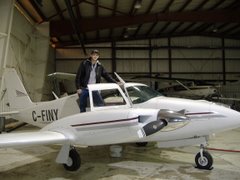Recently I started training for my Multi-Engine Class Rating, in our newly christened 1964 Piper Twin Comanche. My first flight was quite the shock going from the ambling pace of a Cessna 150 straight to the high speed, high demand cockpit of a complex twin. So I am excited to review what I have learned so far.
Just a heads up, this is going to be a fairly technical post, so those not interested in reading procedures and what-not, sorry. Otherwise read on!
For those of you out there who know what a Constant Speed Propeller is, feel free to skip these next two paragraphs, I just feel compelled to give a little background knowledge to those unaquainted with the complex aircraft.
First of all the term "Complex Aircraft" generally refers to an aircraft with retractable landing gear and a constant speed propeller, or in my airplane's case, propellers plural. A constant speed propeller is one where you can control the pitch of the blades. This gives you an advantage similiar to different gears in a car. A fine pitch in the propeller, similiar to a low gear, will give us lots of torque for the take-off and climb, whereas a coarse pitch, like a high gear, will give us a fast cruising speed.
In addition to a power control (controls amount of air aloud into engine) and mixture control (controls amount of fuel aloud into engine) we have a a set of Propeller controls. These don't directly control the pitch of the propeller blades, but actually control a governor that allows the blades to change their pitch in order to hold a constant engine RPM as directed by the prop controls. Hence the name "constant speed propeller". The governor, based on how much power is being delivered to the props by the engine, will adjust the pitch of the blades to either slow down, or speed up the engine as needed to maintain the set RPM. For example. Say we want to set our props to a cruise setting, and right now we have just finished our climb and are in a fine pitch climb setting of 2500 RPM. We will pull back the prop control levers until the Tachometer reads our desired RPM, which we will call 2300. The governor senses that right now the props are spinning at a faster rate then 2300, so it increases the pitch, which in turn loads the engine and slows it down to 2300. If we were to increase the power being delivered to the props by pushing our throttle forward, the props will naturally want to speed up, so the governor will once again increase the pitch of the props in an attempt to keep them spinning at 2300 RPM. So unlike a fixed pitch prop aircraft where power to the engine is measured on the Tachometer, we measure power from the Manifold Pressure Gauge, in Inches of Mercury, and we manage the prop settings using our Tachometer.
Now that we have a little background knowledge, I can talk about the procedures we use for taking off.
For taking off we use a full fine pitch setting for the props, full power to the engines, and no flaps. The Twin Comanche calls for no flaps in take-off, because we don't want to take off while our airspeed is still below Vmc. In a nutshell, the aircraft will be uncontrollable below Vmc if an engine fails. So we want to stay above that at all times. Once we're cleared for take-off, and we've done our crew briefing and are ready to go, we push the power forward, and hold it on the runway centreline as we're sucked back into our seats. Right at about 80 mph, the airplane stops bouncing along the runway and starts flying. Now we'll accelerate in a level attitude just above the runway until we've past Vmc (90 mph) and reached our best rate of climb, which is 112 mph. At this point we'll pitch the nose up and climb out. As soon as we've run out of runway, which is about 5-10 seconds after our wheels left the ground, we transition into the normal climb. Landing gear goes up, we pull the power and props back to our climb setting, and we let our airspeed increase to around 130 to 140 mph for better cooling for the engines. Not long after, we've reached our cruising altitude, so its time for the cruise checklist. Power once again back to cruise power, electric fuel pumps can go off one at a time as we watch our fuel flow gauge for any decrease in fuel flow. If something is wrong with our engine driven fuel pumps we want to be able to identify which one, and if something is wrong with both of them it would also be really nice to not have both engines quit at the same time, cause that would just make for a bad day. The rest of the cruise checklist is pretty standard. Mixtures lean, fuel tank selectors as req'd (also done one at a time), cowl flaps closed, nav instruments set.
I'll post what we do for landing tommorrow maybe, because this is getting a little long and its also getting quite late, and I have to work tommorrow.
Tuesday, December 5, 2006
Subscribe to:
Post Comments (Atom)




No comments:
Post a Comment